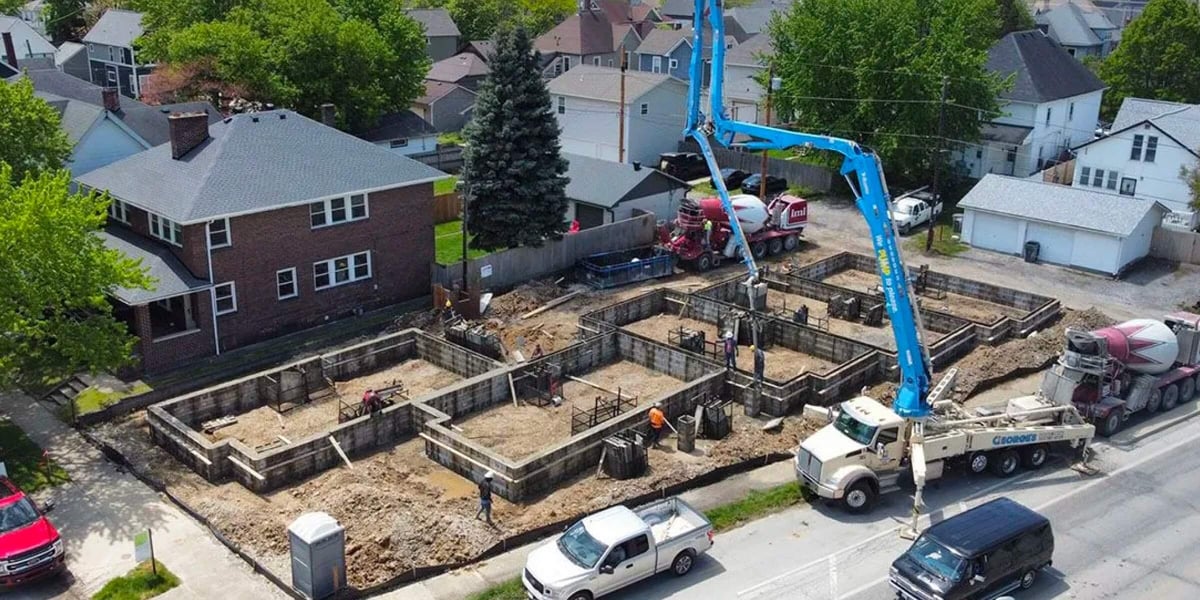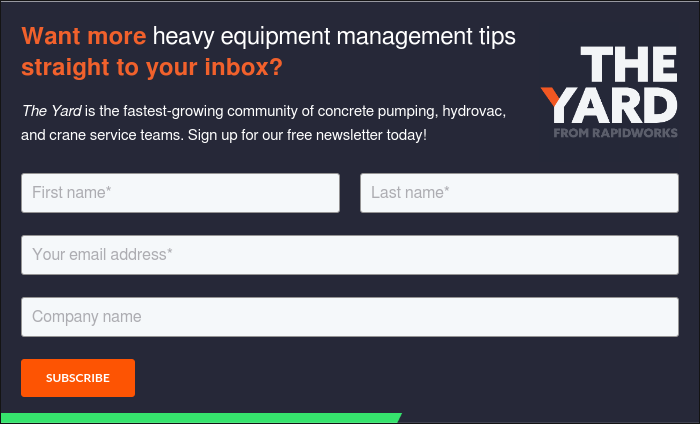Enhance Your Jobsite Safety With A Heavy Equipment Safety Program

Enhance Your Jobsite Safety With A Heavy Equipment Safety Program
When you’re operating heavy equipment, workplace safety comes first. On a busy jobsite, safety protocols may seem like just another box to check, but job training, pre-job safety checklists, and hazard identification are crucial to keeping your operation up and running.
Read on to learn how to create an effective heavy equipment safety program that mitigates workplace hazards and keeps your operation running smoothly.
This article will walk through:
- The Foundation of a Heavy Equipment Safety Program
- Safety Starts Before the Job: Pre-Shift and Pre-Job Checklists
- Make Toolbox Talks a Habit, Not a Chore
- Encourage Reporting and Build a Feedback Loop
- Common Mistakes to Avoid
- Implement an Effective Safety Program to Protect Your Employees and Your Business
The Foundation of a Heavy Equipment Safety Program
A successful heavy equipment safety program needs a solid foundation that establishes the policy, clearly outlines employees' roles within the program, and provides continuous training for actual job hazards.
Start With a Written Policy
Establish a written safety policy that addresses your heavy equipment safety goals. Examples of safety policy goals may include:
- Preventing accidents and injuries
- Meeting regulatory standards
- Protecting equipment from damage
- Reducing unwanted environmental impacts
- Eliminating risky behaviors
- Establishing operator performance goals
- Setting efficiency standards and reducing downtime
The policy should specify the roles and responsibilities of employees within the operation, as well as a reporting process for safety concerns and violations.
Assign Safety Roles
Each procedure within your policy should be assigned to a specific role. For example, you may have the foreman run tailgate meetings or assign walkarounds to operators. With clearly assigned safety obligations, your employees can take ownership of their role in maintaining a safe workspace.
Train for the Real World
Too often, safety training addresses hypothetical issues without addressing the actual safety concerns that employees encounter. Rather than using generalized training, incorporate real situations tied to your jobsite’s actual hazards. Not only will real-world training provide critical information for workers on the job, but it will also encourage engagement by providing relatable advice that employees can use.
Safety Starts Before the Job: Pre-Shift and Pre-Job Checklists
Safety checklists are a crucial tool for establishing a safety-first mindset. Heavy equipment operations should incorporate both pre-shift and pre-job checklists as part of each equipment operator’s regular duties.
A pre-job or pre-work checklist includes an inspection of the worksite and equipment before the project begins, while pre-shift checklists, such as for daily crane inspections, help workers assess the equipment and site conditions before every shift.
Depending on the site and type of equipment, your heavy equipment safety checklist may include:
- Assessing parking and operating areas for stability, moisture, and nearby hazards
- Checking fuel, oil, lubricant, steering, windshield wiper, and hydraulic fluid levels
- Testing safety equipment such as seatbelts
- Noting worn, loose, or broken vehicle parts in need of repair or replacement
A comprehensive security checklist protects your company from unnecessary costs for repairs and downtime. It also reduces the company’s liability for accidents or injuries that may arise. Consider adding a specific hazard identification checklist at the start of every job to identify dangerous conditions that are specific to the location.
Make Toolbox Talks a Habit, Not a Chore
A toolbox talk, also called a tailgate talk, is a great way to connect with your team about safety protocols and potential hazards. Since toolbox sessions are quick and informal, you can easily schedule the meeting at the start of a shift, when everyone is present.
During a heavy equipment hazards toolbox talk, a supervisor or safety specialist gives a short presentation about a specific topic, policy, or procedure. Examples of topics for toolbox talks include:
- Backing up equipment safely
- Operating heavy equipment on a slope
- Navigating overhead power lines
- First aid on the jobsite
- Accident reporting and documentation
- Staying safe in hot conditions
Every worksite has unique hazards and challenges, so consider the specific issues your workers face and address those topics.
Understanding the Advantages of Toolbox Talks
Toolbox talks keep your operation running smoothly by ensuring all of your employees are on the same page when it comes to safety policies and procedures. The advantages of regular toolbox talks include the following.
Increased Awareness and Accountability
Regular toolbox talks integrate safety into your regular operations, establishing awareness and accountability for workers in real time. Periodic discussions about specific safety topics remind workers to take precautions when operating in potentially hazardous conditions.
Enhanced Communication
A toolbox talk provides a space for workers to ask questions and raise concerns about workplace safety. Both workers and supervisors can share their methods and experiences to inform better hazard management. Workers feel more comfortable reporting hazards in an environment that encourages open, nonjudgmental communication.
Reduced Workplace Accident and Injury Risk
When you frequently reiterate safe work policies, employees become less complacent. This helps reduce the potential for dangerous accidents and injuries.
Enhanced Trust Between Employees and Supervisors
Toolbox talks also show your employees that you're serious about their safety. Each meeting reinforces every employee’s role in maintaining a safe environment and shows that you consider workplace safety a priority.
Structure of a Toolbox Talk
Although every talk will differ depending on the topic, your safety meeting should include the following elements:
- Clearly explain the safety issue you're discussing.
- Show how it can cause dangerous conditions and injuries.
- Provide a quick review of your policies and procedures for managing the issue, including any updates to your existing processes.
- Let employees know how to report hazards or policy violations.
- Answer questions and allow employees to share their own experiences.
Learn more details on planning and conducting toolbox talks in our Ultimate Guide to tailgate meetings.
Encourage Reporting and Build a Feedback Loop
The point of checklists and toolbox talks is to encourage communication between all of your employees and supervisors. Open communication among your crew helps all workers take ownership of their role in workplace safety. It also creates an environment in which employees can comfortably and honestly report any incidents that do arise.
A culture of open communication normalizes accountability and encourages all employees to keep their eyes open for safety issues. Facilitate honest reporting by:
- Providing positive feedback and incentives for reporting
- Creating a standard reporting procedure
- Keeping your feedback professional and educational
- Giving workers the option to report issues anonymously
- Fostering a safe management environment that supports accountability
- Following up on issues promptly
- Asking openly for reports and thanking employees when they notify you of an issue
- Making the reporting process quick and easy
Common Mistakes to Avoid
When establishing a safety program, you can expect some trial and error. Even a well-established program will require frequent reviews and updates. To ensure effective implementation, be on the lookout for these common errors.
Treating Checklists Like Tedious Paperwork
When you’re on a tight schedule, it can be easy to think of checklists as just more administrative work. This approach pushes safety aside, making room for accidents, injuries, and expensive downtime.
Avoid downplaying the importance of checklists by making them an integral part of the daily workflow. Have employees complete their safety checklists before every job and at the start of every shift as a matter of policy.
Reusing Toolbox Talk Topics Every Week
It’s easy to get into a rut when you have weekly meetings on safety. Unfortunately, boring toolbox talks can mean disengaged employees. When you want to keep safety at the forefront, it’s important to use relatable and interesting topics rather than repeating the same material.
Try to keep things fresh and engaging for employees by discussing issues that affect the current job. You can get fresh ideas for meeting topics by chatting with your employees about any concerns or questions they have. Assess the project’s workflow to identify bottlenecks and efficiency issues, and review upcoming phases to pre-emptively discuss future safety concerns.
Failing to Conduct Adequate Training
Whether you're teaching new hires about safety protocols or establishing new procedures with existing employees, thorough training is crucial. Operators should have a firm grasp of safety policies and the role they play in enacting safe procedures. They should know how to prevent, identify, and report issues.
Training is an ongoing process, especially when safety procedures must meet changing worksite requirements. Keep your new and existing employees in the loop with thorough training and regular refreshers.
Not Updating the Safety Plan
Even a well-established heavy equipment safety program needs regular updates and reviews to ensure consistency with regulations. Different types of jobs have different safety needs, and you may have to tweak your policies as new circumstances present themselves.
Rather than considering your plan a one-and-done deal, consider it an ongoing project. Use data and information from employee feedback, job feedback, and operational performance reports to continuously improve your safety and efficiency.
Not Reviewing Incidents Promptly
An employee who reports safety concerns feels heard and valued when their report leads to quick action. If you wait too long to handle safety issues, employees may not consider it worth filing a report in the future. Worse, they may think that their safety is not a priority with the company.
You can prevent this by quickly reviewing and following up on incident reports. Even if you can't immediately fix the issue, thank the employee for reporting it and let them know what you're doing to work on the problem.
Implement an Effective Safety Program to Protect Your Employees and Your Business
When you put safety first with your heavy equipment operation, you protect your employees, equipment, and bottom line. Implementing a heavy equipment safety program keeps your operation on track while preventing dangerous accidents, employee injuries, and expensive downtime.
To establish a successful equipment safety program, you need the right tools. RapidWorks offers state-of-the-art tools that are designed to help heavy equipment service providers manage everything from inspections and checklists to safety audits. Our management services can help you create pre-job and pre-shift checklists tailored to your worksite, while our in-depth data analysis lets you pinpoint areas to address during your tailgate talks.
Contact us today to schedule a demo and see how RapidWorks can keep your heavy equipment safety program on track.
